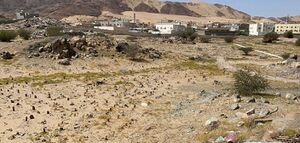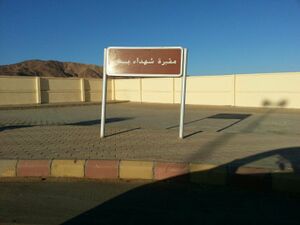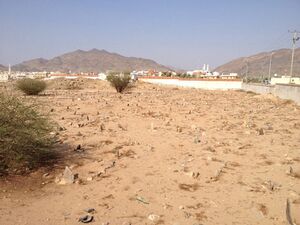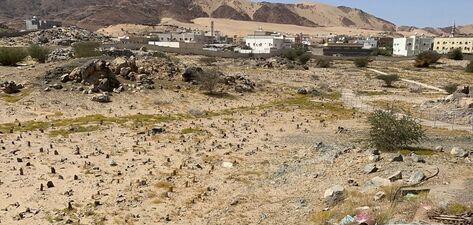Badr Martyrs Cemetery
 | |
| General Information | |
|---|---|
| Place | city of Badr |
| History | |
| Time of Construction | Badr Battle second year of Hijra/624 |
| Events | The place of Badr Battle |
The Badr Martyrs' Cemetery stands as a poignant testament to the historic Battle of Badr, where, according to historical records, the gallant martyrs of the battle found their eternal rest. This revered site is located near the ancient city of Medina in Saudi Arabia, a region steeped in profound historical and religious significance. Historical travelogues and accounts detail that the Badr Martyrs' Cemetery was originally an area adjacent to the Arish Mosque, further enriching its historical context. Today, this hallowed ground is marked by a walled cemetery within the city of Badr, which is solemnly recognized as the final resting place of the revered martyrs of Badr. This site not only serves as a burial ground but also as a lasting symbol of courage and sacrifice, drawing visitors and scholars who seek to connect with the profound legacy of the Battle of Badr. The cemetery continues to evoke deep respect and reverence, underscoring its enduring importance in the annals of history.
The Battle of Badr
The Battle of Badr, also known as Ghazwat Badr, holds a significant place in Islamic history as the first major military encounter led by the Prophet Muhammad (S). This pivotal battle occurred in the second year after the Hijra (624 CE) in the region of Badr, which was then a well-known gathering site for the Arab tribes. Annually, from the beginning of the month of Dhu al-Qi'dah, Badr hosted a market that lasted for eight days, attracting people from various regions.
The confrontation at Badr was a decisive moment in the early history of Islam.[1]"The battle, which lasted for half a day, resulted in a significant victory for the Muslims despite their smaller numbers and limited resources. The Quraysh, the main opposing force, suffered substantial losses with seventy of their men killed and an equal number taken captive. On the Muslim side, the casualties were much fewer, with fourteen martyrs in total: six from the Muhajirun (the Emigrants who had moved from Mecca to Medina with the Prophet) and eight from the Ansar (the Helpers, native inhabitants of Medina who supported the Prophet).[2] The significance of the Battle of Badr extends beyond its immediate military outcomes. It is often regarded as a manifestation of divine intervention and support for the nascent Muslim community. The Qur'an refers to this battle in several verses, emphasizing the themes of faith, perseverance, and divine aid. For instance, in Surah Al-Anfal (8:9-10), Allah reassures the believers of His support by sending angels to strengthen their ranks.
Furthermore, the victory at Badr bolstered the morale of the Muslim community and established their presence as a formidable force in the Arabian Peninsula. It also served as a crucial turning point, strengthening the leadership and authority of the Prophet Muhammad (PBUH) and solidifying the unity and resolve of his followers.
In Islamic tradition, the martyrs of Badr are highly revered, and their sacrifice is commemorated as an embodiment of faith and devotion. The battlefield of Badr and the cemetery where these martyrs were laid to rest continue to be sites of historical and spiritual significance, attracting visitors and pilgrims who seek to honor the memory of those who fought in this momentous battle.
Thus, the Battle of Badr is not only a landmark event in Islamic military history but also a profound testament to the enduring values of faith, sacrifice, and divine assistance that underpin the Islamic faith.
Martyrs of Badr
Most historians agree that the number of martyrs from the Battle of Badr is fourteen. These fourteen individuals are honored and remembered for their ultimate sacrifice in the cause of Islam. The list of these esteemed martyrs includes individuals.[3]
Martyrs of Badr from the Muhajirun (immigrants)
The following is a list of the martyrs from the Battle of Badr who belonged to the Muhajirun, the early Muslim converts who migrated from Mecca to Medina with the Prophet Muhammad (S):
- Ubaida ibn al-Harith (عبیده بن حارث)
- Umair ibn Abi Waqqas (عمیر بن ابی وقاص)
- Umair ibn Abd Amr ibn Nadhla al-Khuza'i (عمیر بن عبد عمرو بن نضله خزاعی)
- Aqil ibn Bukayr (عاقل بن بُکیر)
- Mahja', the freed slave of Umar ibn al-Khattab (مهجع، غلام عمر بن خطاب)
- Safwan ibn Bayda' (صفوان بن بیضا)
The Martyrs of Badr from the Ansar
The following is a list of the martyrs from the Battle of Badr who were from the Ansar, the native inhabitants of Medina who supported the Prophet Muhammad (S) and the Muhajirun:
- Sa'd ibn Khaythama (سعد بن خُثیمه)
- Mubashshir ibn Abd al-Mundhir ibn Zunbur (مبشر بن عبدالمنذر بن زُنبُر)
- Yazid ibn Harith ibn Fus'hum (یزید بن حارث بن فُسحُم)
- Umair ibn Humam (عمیر بن حُمام)
- Rafi' ibn Mu'alla (رافع بن مُعلی)
- Haritha ibn Suraqa ibn Harith (حارثه بن سُراقه بن حارث)
- Awf ibn Harith ibn Rifa'a (عوف بن حارث بن رُفاعه)
- Mu'awwidh ibn Harith ibn Rifa'a (معوذ بن حارث بن رفاعه)
These fourteen martyrs are revered in Islamic history for their bravery and dedication. Their sacrifice at the Battle of Badr is seen as a cornerstone of the early Islamic community's struggle and ultimate triumph. Each of these individuals played a crucial role in the battle, and their memory is cherished by Muslims around the world as exemplars of faith, courage, and steadfastness.
The Modern Region of Badr
Original article: Badr Today, the region of Badr, also known as Badr Hunayn, has developed into a city. It is situated 153 kilometers from Medina and 310 kilometers from Mecca. As of the year 1425 AH (2004-2005 CE), Badr had a population exceeding 33,000 residents, and including its surrounding areas, the population was over 58,000.
This transformation from a historic battlefield into a thriving city underscores the continuing significance of Badr in both historical and contemporary contexts. The city serves as a living reminder of the pivotal events that took place there, and it remains an important site for visitors and pilgrims alike.[4]
Historical Reports on the Badr Cemetery
Among the earliest reports on the Badr Cemetery are those attributed to the historian al-Waqidi (d. 207 AH).[5] According to al-Waqidi's accounts, the graves of the martyrs were scattered across the site.[6] In the 5th century AH, the historian Ibn Biyaqi (d. 458 AH) visited the cemetery and documented its condition. His accounts provide valuable insights into the site's historical significance and its status during his time. These early records contribute to our understanding of the Badr Cemetery's evolving historical and cultural context.[7]
In the 6th century AH, the traveler and historian Ibn Jubayr (d. 578 AH) visited the site where the martyrs of Badr were buried. He observed that the battlefield of Badr had, by that time, been transformed into a lush palm grove, with the cemetery of the Badr martyrs situated behind this grove.[8] Approximately a century later, in 688 AH, the historian and traveler Abdari visited Badr and reported on a large cemetery located to the west of the Arish Mosque. This cemetery was identified as the resting place of the Badr martyrs, reflecting its continued significance and the growth of the site over the intervening years.[9] Several centuries later, in 1110 AH, the scholar Muhammad Tayeb Sharafi al-Fasi (d. 1170 AH) documented his observations of the Badr Cemetery. He described the site as being enclosed by a low wall and noted the presence of a shrine associated with the martyrs of Badr (as detailed in his travelogue, "Safarnameh Sharafi Fasi," p. 354).
In 1179 AH, the historian and traveler Warthalani also reported on the cemetery, describing the wall that surrounded the site. His observations corroborate the earlier descriptions, indicating that the cemetery remained a significant and well-maintained site over time.[10] Overall, the historical reports from these and other sources offer a consistent picture of the Badr Cemetery's preservation and significance. They reflect the site's continued importance as a place of reverence and historical memory, with little variation in the details provided across different periods. These accounts collectively underscore the enduring legacy of the Badr martyrs and the efforts made to honor their memory through the centuries..[11]
The Badr Martyrs' Cemetery Today
During a visit to Badr from 1975 to 1978 CE, researcher Muhammad Ali Najafi provided an assessment of the current condition of the Badr Martyrs' Cemetery. He observed that the graves of the martyrs were located within a larger, general public cemetery in Badr. The graves themselves were flat and unmarked, consistent with the typical style of other cemeteries in Saudi Arabia.
Najafi noted that the martyrs' graves were enclosed by a low wall made of white cement, surrounded by iron railings. This modest enclosure served to delineate the martyrs' graves from the rest of the cemetery, offering a degree of distinction within the broader cemetery context. However, the individual graves remained unadorned and lacked specific markers or inscriptions, reflecting a simple yet respectful approach to their commemoration. Current images of the Badr Martyrs' Cemetery depict a large cemetery enclosed by a white wall. Within this area, the graves are marked with stones, providing clear delineation. This modern appearance highlights the cemetery's continued significance and the efforts made to maintain its respectful and orderly presentation. [12] [13]
Gallary
Notes
- ↑ Wāqidī, Al-Maghāzī, vol. 1, p. 384; Najafī, Madīna shināsī, vol. 2, p. 28.
- ↑ Ibn Saʿd, Al-Ṭabaqāt al-kubrā, vol. 2, p. 12; Wāqidī, Al-Maghāzī, vol. 1, p. 145-152.
- ↑ Zāhidī Muqaddam, Qazwi-yi badr, shuhadā wa mazārāt-i ān, p. 91.
- ↑ Zāhidī Muqaddam, Qazwi-yi badr, shuhadā wa mazārāt-i ān, p. 17.
- ↑ Zāhidī Muqaddam, Qazwi-yi badr, shuhadā wa mazārāt-i ān, p. 110.
- ↑ Wāqidī, Al-Maghāzī, vol. 1, p. 147.
- ↑ Bayhaqī, Dalāʾil al-nubuwwa wa maʿrifat aḥwāl ṣāḥib al-sharīʿa, vol. 3, p. 125.
- ↑ Ibn Jubayr, Riḥla Ibn Jubayr, p. 148.
- ↑ ʿAbdarī, Riḥla al- ʿAbdarī, p. 346-347.
- ↑ Warthīlānī, Al-Riḥla al- Warthīlānīyya, vol. 1, p. 419.
- ↑ Burckhardt, Tarḥāl fī al-jazīra al-ʿarabīyya, vol. 2, p. 193-195; Hājib al-Dawla, Safarnāma Hāj ʿAlīkhān Iʿtimād al-salṭana, p. 97.
- ↑ Najafī, Madīna shināsī, vol. 2, p. 172.
- ↑ Images of Badr Martyrs graveyard
References
- ʿAbdarī, Muḥammad b. Muḥammad. Riḥla al- ʿAbdarī. Damascus: Dār al- Saʿd al-Din, 1426 AH.
- Bayhaqī, Aḥmad b. al-Ḥusayn al-. Dalāʾil al-nubuwwa wa maʿrifat aḥwāl ṣāḥib al-sharīʿa. Edited by ʿAbd al-Muʿṭī al-Qalʿajī. Beirut: Dār al-Kutub al-ʿIlmīyya, 1405 AH.
- Burckhardt, John Lewis. Tarḥāl fī al-jazīra al-ʿarabīyya (Travels in Arabia). Cairo: Al-Markaz al-Raqūmī li-l-Tarjuma, 2007.
- Hājib al-Dawla, ʿAlī b. Ḥusayn. Safarnāma Hāj ʿAlīkhān Iʿtimād al-salṭana. . Tehran: Mashʿar, 1379 sh.
- Ibn Jubayr, Muḥammad b. Aḥmad. Riḥla Ibn Jubayr. Beirut: Dār al-Maktaba al-Hilāl, 1986.
- Ibn Saʿd, Muḥammad b. Manīʿ al-Ḥāshimī al-Baṣrī. Al-Ṭabaqāt al-kubrā. Edited by Muḥammad ʿAbd al-Qādir ʿAṭā. Beirut: Dar al-Kutub al-ʿIlmiyya,1410AH-1990.
- Najafī, Sayyid Muḥammad Bāqir. Madīna shināsī. Tehran: Mashʿar, 1387 sh.
- Wāqidī, Muḥammad b. ʿUmar al-. Al-Maghāzī. Edited by Marsden Jones. Beirut: Muʾassasa al-Aʿlām, 1409 AH.
- Warthīlānī, Ḥusayn b. Muḥammad. Al-Riḥla al- Warthīlānīyya. Cairo: Maktabat al-Thaqāfa, 1429 AH.
- Zāhidī Muqaddam, Muḥammad. Qazwi-yi badr, shuhadā wa mazārāt-i ān. Tehran: Hajj and Pilgrimage Research Institute, 1401 sh.


